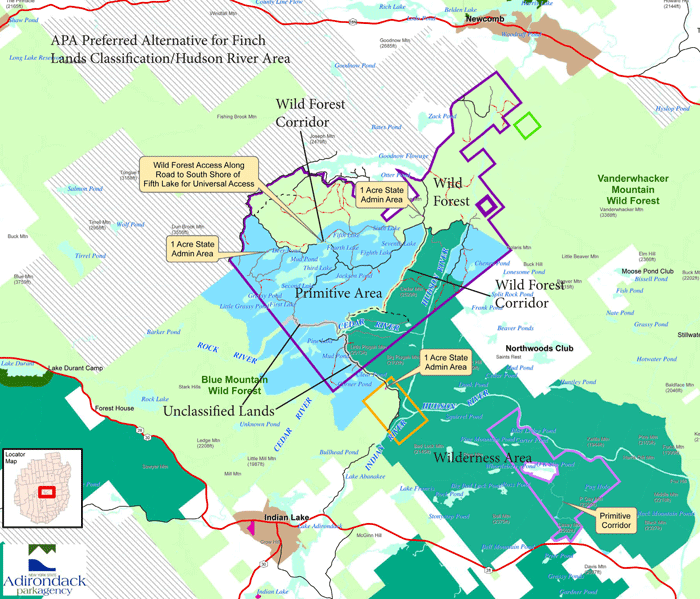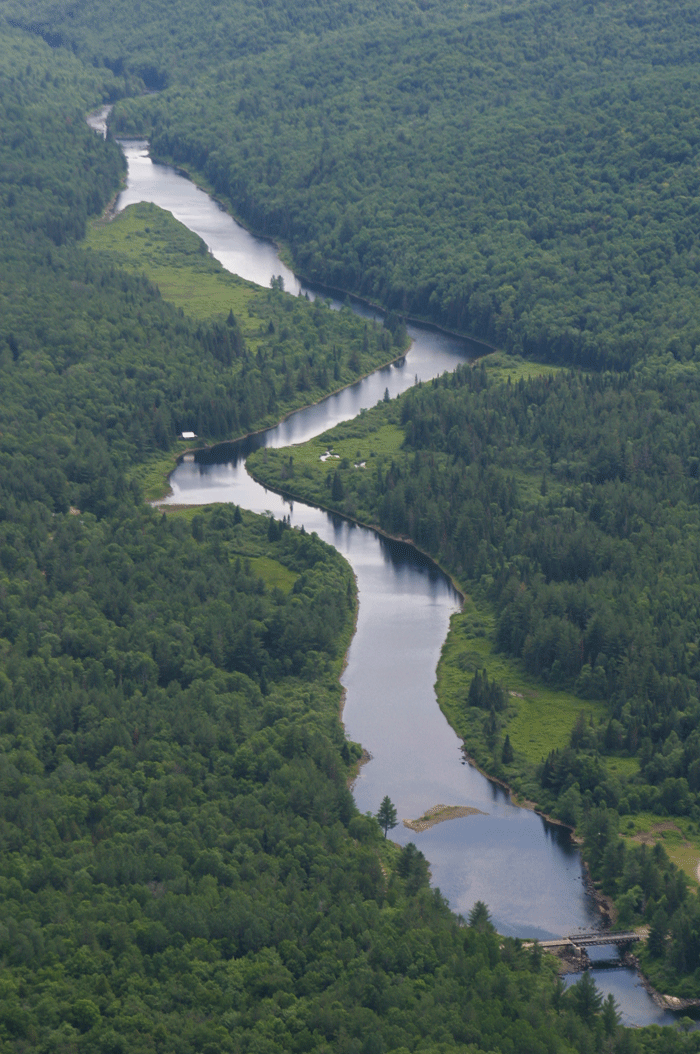The Adirondack Park Agency (APA) has released its preferred alternative for classification of over 21,000 acres of new Forest Preserve lands around the Essex Chain Lakes and Hudson River and reclassification of over 18,000 acres of existing Forest Preserve lands. This recommendation was the product of ongoing negotiations between the APA senior staff, senior staff at the Department of Environmental Conservation, and Governor Andrew Cuomo and his Executive Staff. The APA Commissioners will be asked to approve this alternative next week.
Here’s a PROTECT press release. Here’s an APA press release.
PROTECT will provide a more detailed analysis of this proposal. Here’s a report on the Adirondack Almanack. Here are documents on the APA website (they take a long time to download.)
This classification package creates a new 23,572-acre Wilderness Area that includes more than 15 miles of the Hudson River. This is good news. The new Hudson Gorge Wilderness Area is a welcome addition to the central Adirondacks. This will preserve the wonders and beauty of the Hudson Gorge for all time and protect the Hudson at its wildest.

The APA proposes a new 21,573-acre Wilderness Area for the Hudson Gorge and a mix of Primitive and Wild Forest areas as well as unclassified corridors and a large Wild Forest corridor for the former Finch lands.
The APA preferred alternative also creates 10,000 acres of new Primitive areas, including lands around the Essex Chain Lakes that bans motor boat use and float plane use except where it currently exists on 1st Lake. The preferred alternative also calls classifying over 8,000 acres as Wild Forest, mostly at the north end of the tract.
Protect the Adirondacks called for the classification of the Essex Chain Lakes as a new motorless Wilderness Area. Public comments from the APA’s public hearings in the summer of 2013 ran 4 – 1 in support of a new Wilderness Area for the Essex Chain Lakes. PROTECT is disappointed that the Essex Chain Lakes will not be classified as Wilderness and that motorized use will be permitted all around the lakes and possibly into the core of the Essex Chain Lakes through a Wild Forest corridor. The public overwhelmingly backed Wilderness, but their comments fell on deaf ears at state agencies and at the State Capital.
The proposed Primitive areas and the Wilderness area will be separated by a Wild Forest corridor that runs through the heart of the new lands. This corridor will likely facilitate mountain biking, automobile traffic and snowmobiles use in the future. This APA’s classification process was clearly driven by motor vehicle uses. The protection of natural resources was a secondary consideration. Outside of the new Wilderness area, the APA recommends classifying lands to facilitate a checkerboard of various motorized uses around and in between the Primitive and Wilderness areas.
The guiding law and principles for state Forest Preserve lands in the Adirondack Park is the Adirondack Park State Land Master Plan (SLMP), which states that natural resource protection “should be paramount” to guide land classifications decision. The recommendations of the APA are clearly an effort to include a variety of motorized public motor vehicle recreational uses on these public lands.
This Classification by the APA Changes 40 Years of Practice
The APA’s preferred alternative raises many questions, but seems to mark a sharp departure from 40 years of established process for Forest Preserve classifications and management. Four things stand out from the management of this classification process by the APA and DEC.
1. This is the first Forest Preserve classification package where motor vehicle uses drove much of the entire classification process.
2. The APA’s proposal could fundamentally change the Primitive classification. In the past, Primitive areas were used as a temporary classification for future Wilderness classification, such as the former Lake Lila Primitive area or the current Hudson Gorge Primitive area. Here, the APA is looking to create new Primitive areas, which are likely to be permanent.
3. The classification is predicated on a large Wild Forest corridor through the heart of the area. This is a novel use of a Wild Forest corridor. The Wild Forest corridor also changes the Wilderness and Primitive areas on each side.
4. Lands are being left unclassified as “Pending classification” to facilitate future motor vehicle use. These uses will likely require revisions to existing state laws, policies and official regulations. When this happens, it will mark the first time that existing laws, policies and regulations will be changed to facilitate public motor vehicle uses on the Forest Preserve.
Polaris Bridge should be Removed, No new bridge for the Cedar River
The Polaris Bridge spans the Hudson River on the Finch lands. The road leading to the bridge forms the northern Wilderness-Wild Forest boundary in the APA proposal. This bridge was built as a temporary bridge 15 years ago by Finch Paper for logging purposes. Protect the Adirondacks believes the Polaris Bridge over the Hudson River should be removed. The APA’s preferred alternative calls for keeping the Polaris Bridge. See an aerial of the Polaris Bridge over the Hudson River below.
The Wild Forest corridor proposed by the APA leads to an area where a bridge over the Cedar River once stood. Many have called for this bridge to be rebuilt to facilitate a variety of motorized and non-motorized recreational uses. PROTECT opposes new bridge construction over the Cedar River.
PROTECT believes that the Polaris bridge over the Hudson River should be removed once the private leased rights end and that no new bridge over the Cedar River should be built.






